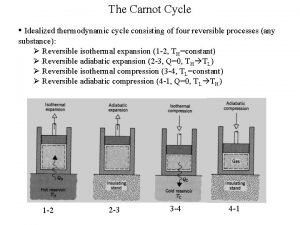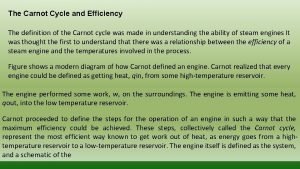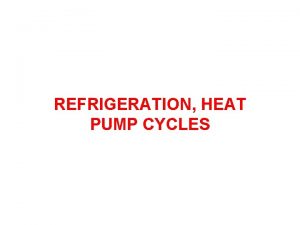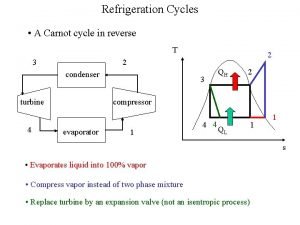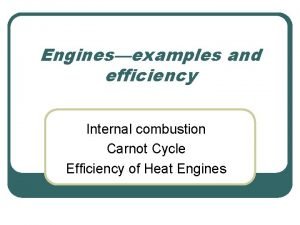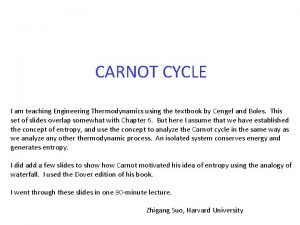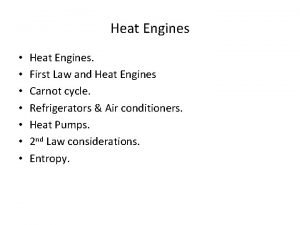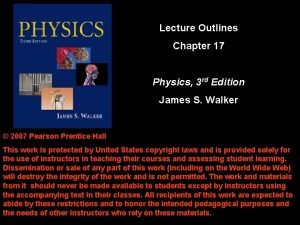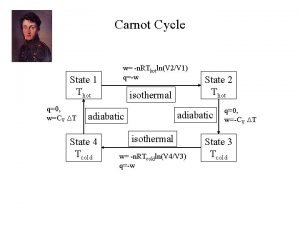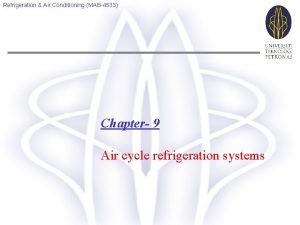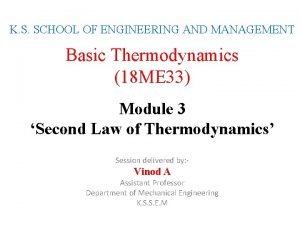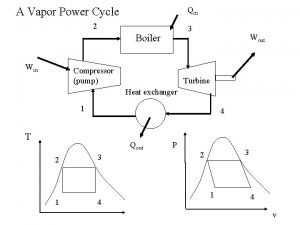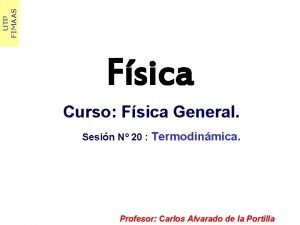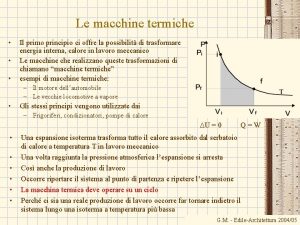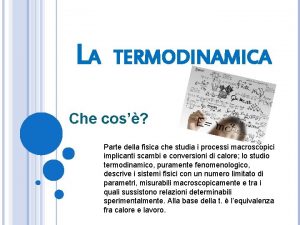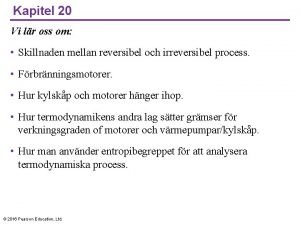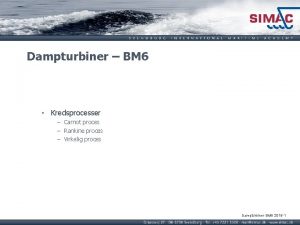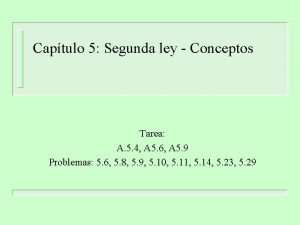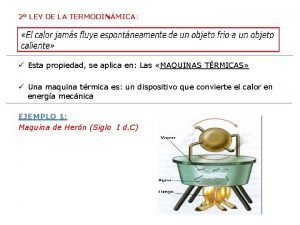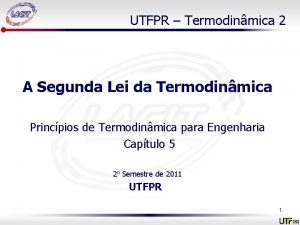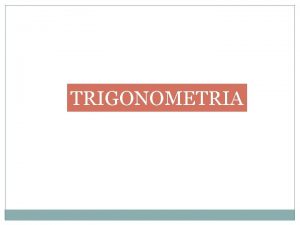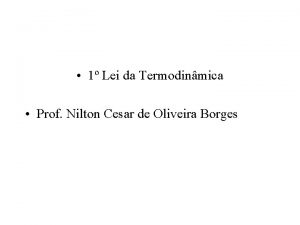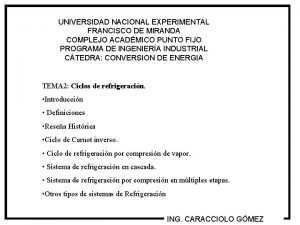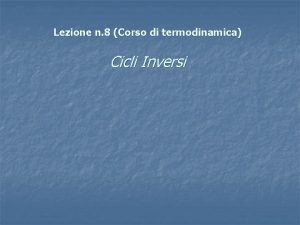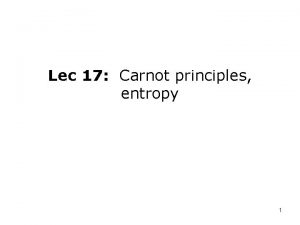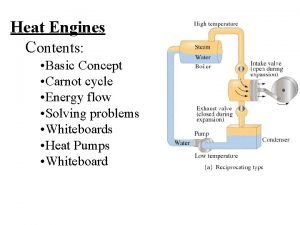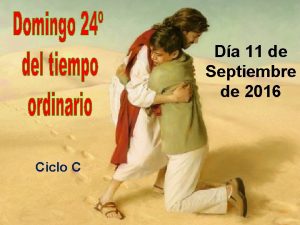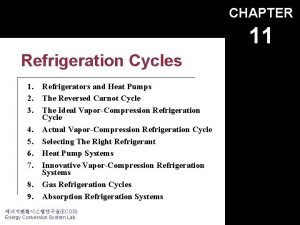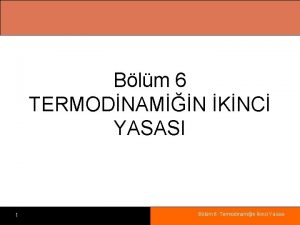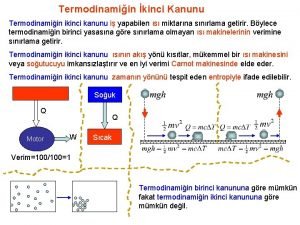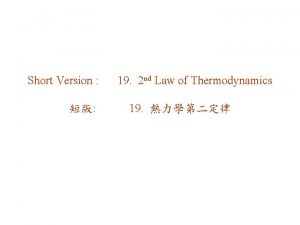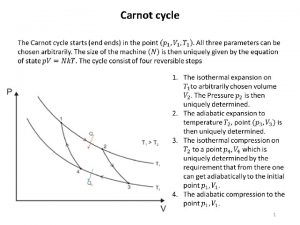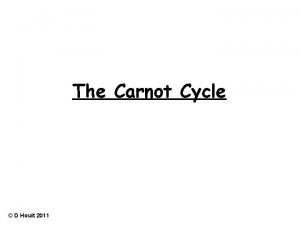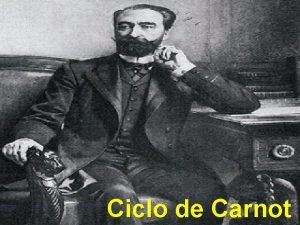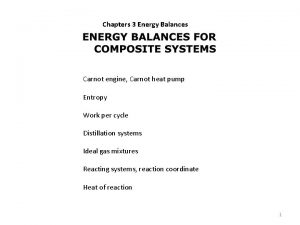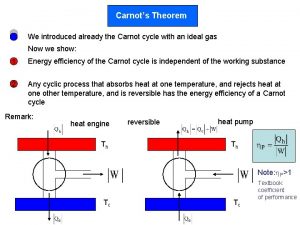The Carnot Cycle D Hoult 2011 The product
















































- Slides: 48

The Carnot Cycle © D Hoult 2011



















The product of pressure and volume represents a quantity of

The product of pressure and volume represents a quantity of work

The product of pressure and volume represents a quantity of work This is represented by

The product of pressure and volume represents a quantity of work This is represented by the area under the curve on the p-V diagram


Work done by the gas during expansion


Work done on the gas during compression


Net work done by the engine during one cycle

The work done by the engine per cycle is indicated by the area enclosed by the curves on the p-V diagram.

The work done by the engine per cycle is indicated by the area enclosed by the curves on the p-V diagram. An obvious way to increase this area is to

The work done by the engine per cycle is indicated by the area enclosed by the curves on the p-V diagram. An obvious way to increase this area is to increase the difference between the temperatures at which the two isothermal changes occur

The work done by the engine per cycle is indicated by the area enclosed by the curves on the p-V diagram. An obvious way to increase this area is to increase the difference between the temperatures at which the two isothermal changes occur We can therefore conclude that the efficiency of a heat engine will be improved if

The work done by the engine per cycle is indicated by the area enclosed by the curves on the p-V diagram. An obvious way to increase this area is to increase the difference between the temperatures at which the two isothermal changes occur We can therefore conclude that the efficiency of a heat engine will be improved if the difference between the temperatures of the heat source and heat sink is increased

It is important to notice that the Carnot cycle (as described above) is completely

It is important to notice that the Carnot cycle (as described above) is completely reversible

It is important to notice that the Carnot cycle (as described above) is completely reversible During the Carnot cycle, a quantity of energy is transferred from a hot body to a cold body and work is done by the gas



It is important to notice that the Carnot cycle (as described above) is completely reversible During the Carnot cycle, a quantity of energy is transferred from a hot body to a cold body and work is done by the gas If the procedure is reversed the same quantity of energy is transferred from a cold body to a hot body and the same quantity of work is done on the gas

Carnot suggested that for a given temperature difference between source and sink, no heat engine can be more efficient than a reversible engine

Carnot suggested that for a given temperature difference between source and sink, no heat engine can be more efficient than a reversible engine In practice, for the process to be (almost) reversible:

Carnot suggested that for a given temperature difference between source and sink, no heat engine can be more efficient than a reversible engine In practice, for the process to be (almost) reversible: The isothermal changes must be made

Carnot suggested that for a given temperature difference between source and sink, no heat engine can be more efficient than a reversible engine In practice, for the process to be (almost) reversible: The isothermal changes must be made very slowly

Carnot suggested that for a given temperature difference between source and sink, no heat engine can be more efficient than a reversible engine In practice, for the process to be (almost) reversible: The isothermal changes must be made very slowly The cylinder must be perfectly

Carnot suggested that for a given temperature difference between source and sink, no heat engine can be more efficient than a reversible engine In practice, for the process to be (almost) reversible: The isothermal changes must be made very slowly The cylinder must be perfectly insulated

Carnot suggested that for a given temperature difference between source and sink, no heat engine can be more efficient than a reversible engine In practice, for the process to be (almost) reversible: The isothermal changes must be made very slowly The cylinder must be perfectly insulated There must be no

Carnot suggested that for a given temperature difference between source and sink, no heat engine can be more efficient than a reversible engine In practice, for the process to be (almost) reversible: The isothermal changes must be made very slowly The cylinder must be perfectly insulated There must be no friction
 Carnot cycle efficiency
Carnot cycle efficiency Cycle efficiency is defined as
Cycle efficiency is defined as Differentiate between refrigerator and heat pump
Differentiate between refrigerator and heat pump Reverse carnot cycle
Reverse carnot cycle Carnot cycle
Carnot cycle Carnot cycle
Carnot cycle Hurricane carnot engine
Hurricane carnot engine Animatedengines.com otto
Animatedengines.com otto Carnot cycle efficiency depends upon
Carnot cycle efficiency depends upon Entropy of diamond
Entropy of diamond Cop of reversed brayton cycle
Cop of reversed brayton cycle Reversed carnot cycle
Reversed carnot cycle Carnot vapor power cycle
Carnot vapor power cycle Product life cycle kotler
Product life cycle kotler Esta compuesto
Esta compuesto Thermodinamika
Thermodinamika Rendimento macchina termica
Rendimento macchina termica Il primo principio della termodinamica
Il primo principio della termodinamica Carnot cykel
Carnot cykel Diesel körfolyamat
Diesel körfolyamat Formule inverse rendimento carnot
Formule inverse rendimento carnot Carnot virkningsgrad
Carnot virkningsgrad Eficiencia de carnot
Eficiencia de carnot Máquinas de carnot
Máquinas de carnot Entropia chimica
Entropia chimica Kelvin planck ifadesi
Kelvin planck ifadesi Compressão isotérmica
Compressão isotérmica Lei dos cossenos
Lei dos cossenos Ciclo de carnot
Ciclo de carnot Ciclo de carnot
Ciclo de carnot Ciclo de carnot
Ciclo de carnot Ciclo ideal de carnot
Ciclo ideal de carnot Borda carnot
Borda carnot Carnot inverso
Carnot inverso Coefficient of performance of refrigerator
Coefficient of performance of refrigerator Inhomogenitás
Inhomogenitás Carnot
Carnot Ciclo de carnot
Ciclo de carnot Diferencia entre licuación y condensacion
Diferencia entre licuación y condensacion Carnot cop
Carnot cop Carnot ısı makinesi
Carnot ısı makinesi Adyabatik tersinmez genleşme
Adyabatik tersinmez genleşme Triangulo exincentral
Triangulo exincentral Dinamika rotasi
Dinamika rotasi Carnot cop
Carnot cop Carnot engine
Carnot engine Prinsip carnot
Prinsip carnot Koefisien daya guna
Koefisien daya guna Joint product adalah penggabungan dua product
Joint product adalah penggabungan dua product
